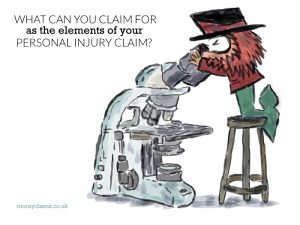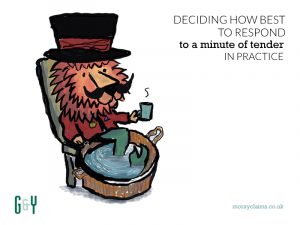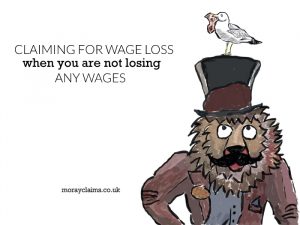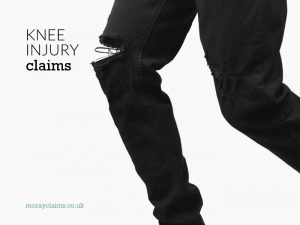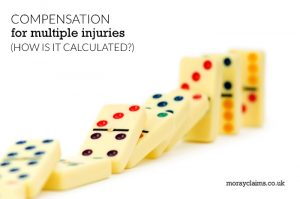(NOTE: This is an updated version of a post originally published on this website on 24 October 2013). If you have been injured in an accident, it may well have put you out of action for a while with the result that you needed help from members of your family. The law in Scotland allows relatives to claim compensation for the time they give up to help you. This might seem strange: you would hope and expect they would do that anyway, without requiring any financial reward. On the other hand, if they were not there to help you, it would make life awkward, at best, and unmanageable, at worst, unless you could get help from some other source. So it makes sense that compensation should be available for them for the time involved in providing you with assistance. Their claim does not stand on its own; it can only be made as part of a personal injury claim by you, the injured person. Two Types of Services Claim There is the possibility to make a claim for two different types of services under Continue Reading
How the Cost of Living Crisis affects the Value of Your Personal Injury Claim
In July 1971, a sliced white loaf of bread would have cost you 10 pence. In July 2021 the cost would have been £1.06. The Retail Price Index ("RPI") shows an average cost for the same loaf of bread as £1.36 in July 2023. The rise in prices over time is known as inflation. It can also be described as the decline of purchasing power over time. In the present Cost of Living Crisis, the upward trend in prices is affecting most things and that includes personal injury compensation (compensation also sometimes referred to as “damages”). The injury part - for the "pain and suffering" associated with the injuries - of a personal injury compensation claim is just one element of the value of the claim as a whole. Other elements can include wage loss and necessary travel expenses. In this article, we are only discussing the injury part of personal injury claims. This can be variously described as "pain and suffering", General Damages and solatium. Continue Reading
How pain and suffering valuation guidelines underpin personal injury claims
What do you do if you’re sailing and your mast breaks? In the 2013 Atlantic Rally for Cruisers, in which small sailing vessels travel from Gran Canaria to the Carribbean, that happened to one of the participating boats. Pollux, from France, with her 2-man crew was only 140 miles from her final destination of St. Lucia, when she was dismasted in a heavy squall. The crew did not panic. Applying the concept of ‘jury-rigging’ – a term used to describe the actions of makeshift running repairs made with only the tools and materials on board – they rigged a windsurfing sail as a temporary replacement on their remaining “half mast”. It helped that the final stretch was downwind and, in the end, they lost remarkably little time because of the mishap. A few adaptations and they still achieved the desired result – getting “home”. But without the enforced adaptations they would not have made it to their destination. In valuing personal injury claims in Scotland, it can sometimes Continue Reading
What all can you claim for with a personal injury claim?
The style of lettering you use for words can have life and death consequences. Research by the AgeLab at Massachussetts Institute of Technology (MIT) has noted how car dashboard interfaces, if designed correctly, should minimise the amount of time the driver has to spend looking at them. The longer you take to work out what's on the screen, the less time you're looking at the road. Some typefaces are rigid and uniform. Their letters and numbers can look highly similar to each other. But other typefaces have much more open spacing and varied letter shapes. These latter fonts can shave precious milliseconds off the time drivers spend looking away from the road. Getting this form of visual communication right is important because the consequences for vehicle travellers' safety could be serious. With personal injury claims, one thing you need to get right in order to avoid potentially serious consequences is the valuation of the claim. With personal injury claims, your Continue Reading
Deciding how best to respond to a Minute of Tender in practice
Tea drinking is a national pastime in Nepal. They have all sorts of teas - sweet, butter, hot, cold, black, white. The ritual with tea is that, when offered tea, you decline it and your host insists that you have some. No matter how much you say no, they still insist that you have it. So you drink it. In other words, it's a situation with drink consumption where "no" means "yes". With personal injury court actions, as the claimant, if your opponent offers you settlement via a Minute of Tender, you want to say "no" (because you always want them to make you a better offer). Unfortunately, you might find that however much you say "no", depending on the level of offer, your legal adviser may have to insist that you say "yes" and accept it. It's one of the situations that can happen with Minutes of Tender. You think your personal injury claim’s worth £20,000 but you’ve got a formal offer (Minute of Tender) in your court action to settle at £10,000. Should you accept the Continue Reading
Claiming for wage loss when you are not losing any wages
You don’t usually get something for nothing. We’ve talked about that issue before when answering the question: How does your personal injury solicitor make money if they do not charge you anything? In the context of a personal injury compensation claim, claiming for wage loss when you are not losing any wages sounds like getting something for nothing – getting a windfall - but it’s not like that at all. To understand how you might claim for future wage loss when you’re not currently losing any wages, we need to consider 3 things, which we’ll do in the remainder of this article. Firstly, how is wage loss normally calculated? Secondly, in what circumstances, might you be able to claim wage loss when you’re not losing any wages? And, finally, how is the calculation made? Let’s look at wage loss claims generally, for a start. If you have a personal injury claim, wage loss may be an important part of your claim. It may be the main reason you decided to make a claim at Continue Reading
When you need to get copies of your Medical Records (Pitfalls to avoid)
“Can he really play?” “Heavens, no! He never played a note in his life” That’s the caption accompanying what is reckoned to be one of the most copied advertisements in history. The headline? "They Laughed When I Sat Down At The Piano - But When I Started to Play!" This 1927 newspaper masterpiece by John Caples has become a prime example of how to sell to people by tapping into their emotional desires through storytelling. The long-form advertisement was to promote a (free) book entitled “Music Lessons in Your Own Home”. Even the legendary comedian, Bob Monkhouse, copied the format for one of his best gags: “When I first said I wanted to be a comedian, everybody laughed. They're not laughing now.” Copying others’ style can apply whether you are writing an advertisement or a joke. Copying can also apply to medical records – and that’s what we’re looking at in this article. We’ll consider three questions relating to medical records in personal injury Continue Reading
Knee injury compensation claims
Dr Carl Wunderlich, who died in 1877, is famous for his measurement of average healthy body temperature of 37°C. (98.6°F). Using a thermometer reputedly a foot in length - and needing 20 minutes to register the temperature – he tested around 25,000 patients and took over 1 million readings. He was at the forefront of medical science for his time but his “normal body temperature” of 37°C has gradually been seen as an oversimplification of reality. In fact, normal temperature is actually a range because no two human bodies are the same. In addition, we all react differently to external factors and disease. Body temperature can also vary according to: how much we’ve eaten; our stress levels; hormones; and different levels of exercise. Something – normal body temperature - that, at a glance, seems simple turns out to be much more complicated. And this is also the case with the human knee. On the face of it, the knee simply joins the top of the leg with the bottom of the leg. Continue Reading
When can you claim for the loss in value of a repaired car?
Where there is a personal injury claim arising out of a road traffic accident, there is often a claim for damage to a car as well. As we have discussed elsewhere, claims for damage to vehicles will be valued on the basis of the lower of: the cost of repairs; and the net pre-accident value of the vehicle (in other words, the pre-accident value of the vehicle, less any scrap value). Another way of putting it is to say that, if the cost of repairing your vehicle will be “too high” relative to its value, the maximum you will get for it will be its net pre-accident value. What if your car was very new when it was damaged? In that case, while it may be economical to repair the vehicle, you might well feel that your repaired vehicle - even if it has been very well repaired – has lost value compared to what it would have been worth for resale if it had not been in an accident at all. It’s an interesting question: whether the owner of a car which is damaged in a road traffic Continue Reading
How does your solicitor negotiate your personal injury claim with the insurers?
We got some questions from a client about the general issues which arise when you're negotiating a personal injury claim with an insurance company. An article seemed like a good way to bring these answers to a wider audience. (Note that we have also based a podcast on these same questions - go here if you would prefer to listen rather than read). We're talking about the stage in a claim where liability has been admitted and it's about maximising the settlement figure with the insurers. The hope is that it will be possible to agree a figure by negotiation but, in the background, there's always the possibility that you might need to raise a court action to achieve a reasonable level of compensation. What tactics and strategies apply here? Do we have to show our hand first rather than let the insurer make an initial offer? This is generally the way it is done. Claims in Scotland are most often negotiated according to a pre-action protocol - basically, an agreement between Continue Reading
What do we mean by Full Compensation for Personal Injury?
My all-time favourite cartoon characters are probably Calvin and Hobbes. Calvin is a young boy of about 6 years of age. To everyone else in the stories, Hobbes is Calvin's stuffed toy tiger. But, to Calvin, Hobbes is his walking, talking best friend – caught by means of a tiger trap baited with a tuna sandwich - who shares all his adventures. Many of these involve stressing out his long-suffering parents. Calvin is precocious in some ways but naive in others. The father of the creator of Calvin and Hobbes, Bill Watterson, was a lawyer. In the cartoon, Calvin's Dad is also a lawyer. I don't have a son called Calvin but we did call one of our cats 'Hobbes'. One comic strip has Calvin sitting, surrounded by what appear to be pots of glue and plaster. He is holding out a baby tooth that has just come out of his mouth. "Mom says the tooth fairy might give me 50 cents for this tooth," he tells Hobbes. "Wow!" replies Hobbes. "So I got an idea," continues Calvin. "I Continue Reading
Compensation for Multiple Injuries (How it’s calculated)
On 24 July 2017, the Boston Globe newspaper reported something which it appears came as a surprise to many people. Some had suspected the truth they exposed in their article, but not many. The subject was pedestrian crossings at busy road intersections. If you needed to cross the road, for example, in downtown Boston, you would press the “walk” button and wait patiently for the lights to change. Your assumption was that you set in motion an electronic process which reduced the time you would have to wait to get your opportunity to cross. As it turned out, however, this was an illusion. The buttons had been disabled. Pedestrians always had to wait a predetermined amount of time within the cycle of the lights. A spokesperson on behalf of the city of Boston explained that downtown was too congested with pedestrians and cars to allow any single person to influence the traffic lights’ cycle. This did not surprise everyone: one resident, who had suspected the buttons were Continue Reading



